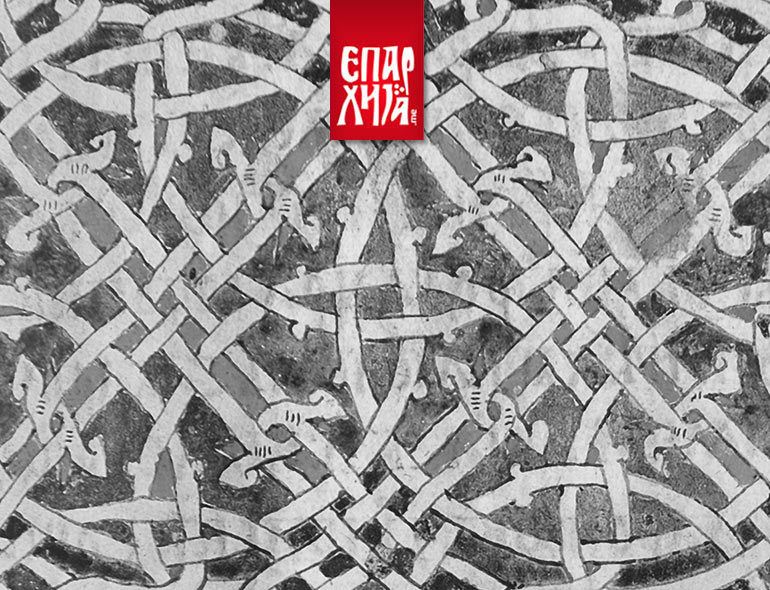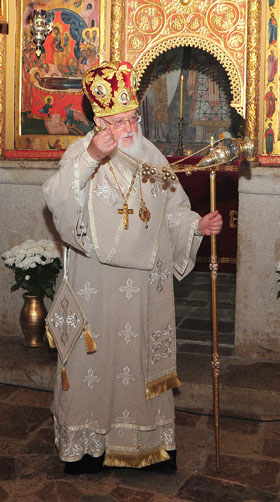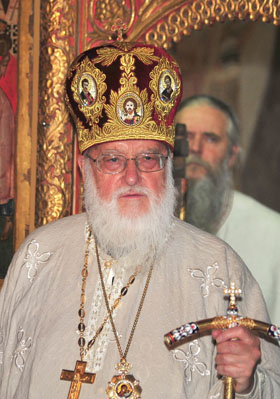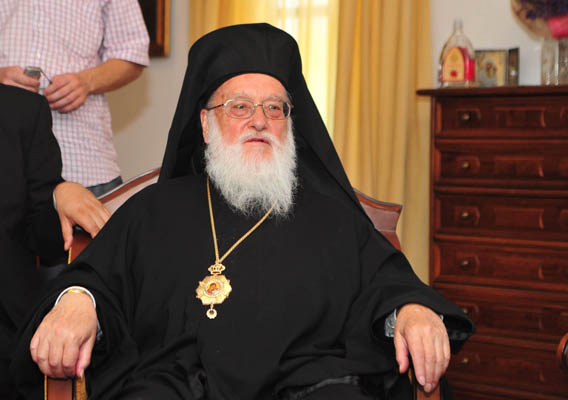
Interview with His Eminence Metropolitan of Diokleia Kallistos Ware
In Piva Monastery, Montenegro, The Feast of the Dormition of Theotokos, August, 28/15, 2012.
Your Eminence, as a president of the society „The Friends of Mt. Athos“, could you tell us a couple of words about the role and significance of Athonite spirituality in the United Kingdom and in the Western world.
The first think to keep in mind is that Athonite monasticism is something universal. It belongs to entire Orthodox Church. Of course, the greater part of the monasteries on the Holy Mountain belongs to the Greek tradition, but Athos has never been exclusively Hellenic, as we know, there are Russian, Bulgarian and above all Serbian monasteries on the Holy Mountain. In the Byzantine era there was even a Latin monastery on the Mount Athos with monks using Latin in their services. So in this way, for us Orthodox in the West, Athos also is a center. The universal center of attraction, representing the highest ideals of Orthodox monastic prayer and spirituality.
The Society, Friends of Mt. Athos are under the patronage of HRH, prince of Wales. Could you give us a deeper insight into the role of Prince Charles and the dedication of His Highness to the restoration of Hilandar Monastery which is very positively highlighted in our public?

Prince Charles has a deep interest in traditional spirituality and in traditional art. He is concerned that the values of the past should not be forgotten. And he is concerned that we should not merely see these values as something theoretical they have always had a practical expression a physical, external expression through works of art, and therefore he sees a great importance for traditional art. There is a princess’s school for traditional art, that he has founded in London and his interest, therefore in the Holy Mountain of Athos and his connection with Friends of Mount Athos is a part of the wider whole. He is deeply concerned that the traditional vision of reality, of the relationship between God, human beings and the world of nature should not be forgotten in this material age.
Your Eminence is the Chairman of the Anglican-Orthodox Theological Dialogue. Good relationship between the Anglican and the Serbian Orthodox Church date from the first half of 20th century. Friendship between St. Nikolaj Velimirovic and bishop George Bell is perhaps best known fruit of this relationship. Could you tell us more about the history of this dialogue, its present state, about common grounds between the Orthodox and the Anglican Church, as well as about major obstacles on both sides?
Yes, you are quiet right to emphasize that contacts between the Orthodox Church and the Anglican Communion a e not a new thing. They have roots going right back to the 17th century. And I am very glad that you referred to the correspondence between Saint Nikolaj Velimirovic and bishop George Bell, a holy and saintly person. And this correspondence has been published in English, and it shows how across divisions of different nations, across divisions of divided Christians, there can yet exist a profound spiritual friendship, as between these two great men, and in the past, the Anglican church has rendered great service to the Orthodox. In Britain, around the time of the Second World War and afterwards, the Anglicans put many churches at the disposition of the Orthodox at the time when the Orthodox came without material resources to England, the Anglicans helped them. And we Orthodox should not forget this and we should continue to be grateful. Now, the present dialog is an important and positive expression of our long standing friendship. It is fundamentally a theological dialogue; therefore we are concerned to understand better the doctrinal positions of our two churches. We do not imagine that this dialog will quickly result in full unity. There are many differences between our two churches. Within Anglicanism there exist many varieties of doctrinal understanding, and therefore we Orthodox have a deep sympathy, for the High Church group among the Anglicans, the so called Anglo-Catholics. Many of them are very close to the Orthodox Church. But there are also other tendencies within Anglicanism. The evangelical-protestant tendency and also the liberal tendency, so it is not easy for the Orthodox to be united with all the Anglicans, but through the present dialog we can understand each other better, we can understand better what it is that the Anglicans believe, but also we Orthodox through meeting the Anglicans, through answering their questions can come to understand ourselves better. All too often our Orthodox Tradition remains for us a hidden treasure. We do not know exactly who we are and by meeting others, by answering their questions, we can grow as Orthodox in self-knowledge.
The most substantial work of Your Eminence is the translation of liturgical texts. Translation activity of both biblical and liturgical texts from Greek, Hebrew and Church Slavonic into modern Serbian is very live in the Serbian Orthodox Church. Can Your Eminence give its views on translation of sacred texts in general, some rules and guidelines for this type of translation work? Using newer, liberal forms, vs. older more conservative forms of language, etc.

Yes, first there is a serious pastoral need for Orthodox liturgical texts in English. The young people, the children of Serbs, Greeks Russians or Romanians, the young people who have been brought up in Britain only have a very imperfect knowledge of the language of their mother countries. and So we need to have translations in English. First there is the question what kind of English shall we use. In the translations on which I have worked in collaboration with the late mother Mary of the Russian monastery of the Bussy-en-Othe who was British we worked on the principle of using what may be termed traditional English, which means basically the liturgical language used in Britain in the XVI and XVII century and used since then by the Anglican Church, and we started our translations over 40 years ago. Today, most people favor using more contemporary English, not entirely colloquial, dignified, but contemporary. Mother Mary and I have been brought up to pray to God with this older form of English. We both believed that liturgical English from this period of the XVII century is fully intelligible to people today, and we believed that it is a treasure that should not be forgotten. Some people agree with us others do not, but we had to translate in the manner known to us. If you are going to do liturgical translations a number of things are essential. First of all, the translations must be faithful to the original and therefore it is important that some of those doing the translations have close familiarity with, first of all, with Septuagint Old Testament, Greek Old Testament, which was what the Fathers were using, and the liturgical texts of full of references to that. Secondly it is important that the translators should be familiar with the works of the Fathers, that they should be familiar with the patristic theology, but it is important that the translation should not only be accurate but that it should be so far as it lies in our power, poetic and beautiful. For the Slav peoples, fortunately, Saint Cyril and Saint Methodius and their disciples, had the ability to translate into a Slavonic language that was not only truthful to the original but also of beauty, and so the work of the apostles of the Slavs bow witness to the beauty of the divine worship. We English translators must try to imitate them, to produce something that will be truthful, yes, but also beautiful, that can be read aloud and sung, that can be fitted to the traditional Orthodox chants. All of that is quiet hard. What mother Mary and I have done is no more than a beginning. I hope that others will carry the work further.
How does Your Eminence see perspectives that lay ahead of the Orthodox Church given great challenges of increasingly changing world? Can the world see the Orthodox Church as THE Church, not only as a mere ethnic experience of the Faith? Which challenge of modernity should an Orthodox Christian be concerned with the most?
You are quiet right to emphasize that Orthodoxy is the Church. It is the Catholic, Universal Church of Christ on Earth. We respect the other Christian bodies, but we believe that the Orthodox Church is the One True Church of Christ on Earth. Not because of our own merits, for we are sinners, but because of God's Grace and we must not forget this. The ethnic element in Orthodoxy,the different national traditions, Serbian, Greek, Romanian, Russian, Georgian, these are very precious, but they must not obscure, the fundamental, Ecumenical and Catholic element of the Orthodox truth. We are not here as a group of ethnic associations, we are here as the church of Christ on Earth, so we need to keep this in mind. To preserve all that is good in our national heritages, but never to allow the ethnic element to obscure the catholic unity of the Church. We could use the analogy of a glass of water. The water in the glass is the life giving through of Orthodoxy. The glass that contains the water is the ethnic traditions that hold us together. To drink the water we need the help of the glass, but the glass must be transparent, not opaque. we must be able to see the thought of Orthodoxy through the glass; we must not forget that it is the drink of water that matters, not the glass.
The largest challenge of modern world surely is the presence, throughout Western society, of a deeply secular outlook. Certainly in Britain, in Western Europe, in North America, the great majority of people have lost a sense of the immediate presence of God in the world. Yes, of course, there are many people who still go to church, but they do not have an integral world view where Christ enters into every aspect of daily life. Religion has been pushed into a corner, something that we do for an hour or two on Sunday and then we get on with the rest of our life. But let us remember that the Christian is the one who where ever he or she looks, sees everywhere Christ and rejoices in him, so this is the greatest challenge to see Christ everywhere, to see all things in God and God in all things, to void a separation between the sacred and the secular. All things can be sacred; the presence of the Holy Spirit can be found everywhere. So this is the most important challenge in the modern world, to resist the separation between the sacred and the secular, to resist the tendency to isolate Christianity into a tiny corner, to see that Christ enters every aspect of our daily life.

Your writings are well known and studied in our theological circles. What is occupying your scientific attention at the present moment?
First of all, I have been working with others on Saint Seraphim of Sarov, a Russian Saint who has a universal significance, who is loved throughout the Orthodox Church and far beyond and we have been preparing an English translation of the main work concerning St. Seraphim that is entitled “The chronicles of the Seraphim-Divyeyevo monastery". I do not know if it is translated to Serbian. It was published in Russian in 1994, and now we are preparing an integral translation into English - 850 pages, and just before I left for Serbia, I was preparing the introduction to this book. So this would be a primary source on St. Seraphim, all the biographies are based on this, it is good to have the original text, rather than a paraphrase or selection.
So, that is the first task, the second task that I am engaged on is the completion of the English translation of the Phylokalia, the “Dobrotolubie”, we started on that, various of us and myself included for over thirty years ago. We have published four volumes, now the fifth volume remains. My collaborators have died, I must work with them on the work that have left and hope to complete that.
A third task that I have in mind is a book partly written about the divine liturgy, about the meaning of the Eucharistic Sacrifice, so well I am 78 now perhaps I don’t have very much longer to live so that is quiet enough to keep me busy for the time being.
You have been visiting Montenegro earlier. Do you see any changes in church Life comparing to your previous visits?
I see significant changes, encouraging changes. I first came to Serbia and Montenegro in 1970. And at that time, it has to be confessed, that the influence of communism was very apparent in the community. I remember coming to Cetinje and I was there for the feast of The Birth of Mother of God - 8/21 of September. I went to the main church in Cetinje, to the Monastery for the vigil service. There was one monk officiating one monk singing and in the congregation one old lady and myself. Just four of us for this great feast, in the ecclesiastical center of the Orthodox Church in Montenegro. When I have been back more recently in the times of metropolitan Amfilohije. I have found the monastery there full of monks the young people, many people praying. So I have seen there a renewal. I remember how on my earlier visits I used to see very few people coming for holy communion. This time 9 days ago, Sunday the Feast of the Transfiguration, I was in St. Mark’s church in Belgrade. The church was full, and nearly everybody came for Communion, you would not have found that forty years ago in the Serbian Church. I think there has been a big change, partly the influence of father Justin Popovic, and of his disciples, such as bishop Atanasije Jeftic, and bishop Irinej Bulovic of Novi Sad and also Metropolitan Amfilohije and others, and I think this group of bishops has produced a big change in the Serbian and Montenegrin church. I noticed also the influence of the saintly Patriarch Pavle whom I met, a person of wonderful simplicity and humility of character, so it seems to me, that between 1945, let us say, and 1975, 30 years where the Church suffered under communism, but now the last 35 years1975 till today the Church has regained much of its position. One priest, an elderly priest I spoke to some years ago, said to me: “things are better now than they were in the 1930, then we had all the protection of the state and its support, now we do not have such support, from the state but we are more Christian”, so I bless god and I hope that the renewal may continue among the Serbian and Montenegrin people.
Interview led by Kosta Dojic





